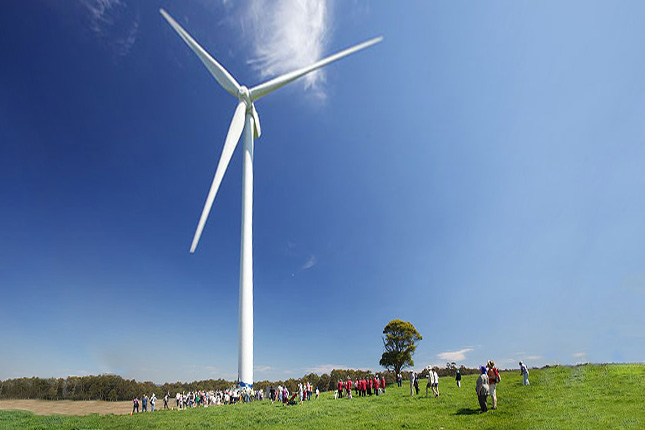The big gap in our arsenal to expand renewable energy – between home systems and power utilities – can be filled by community energy, and it can’t happen too soon.

Locals take pride in their handiwork at Hepburn Springs community wind farm.
In humanity’s greatest challenge – to survive and thrive without screwing the planet – two key ingredients are renewable energy and leadership.
We all know in our hearts that we need radical changes in the way we energise our lives, on a massive scale. So far this hasn’t happened, but big changes are in the air. Quite soon –maybe even this year – absolutely everyone will know the process of transformation is under way.
Crucial pieces of the jigsaw are now falling into place as the public at large, ignoring anti-renewable rhetoric, acknowledges the clear trend to cleaner energy. People are voting with their wallets as they see the long-term cost-benefit from installing solar panels.
The figures tell the story. With panel costs dropping rapidly as grid power gets more expensive, the number of installed solar panel systems in Australia increased 40 times between 2009 and 2016.
In 2017 installed capacity rose by nearly 20 per cent, putting the total generating capacity of solar panels well above 7000 megawatts across Australia, with numerous commercial plants and over two million home systems in place.
Renewable energy market analyst Ric Brazelle predicts that photovoltaic solar in Australia this year will outshine every other year, adding over 3500 megawatts to installed capacity including some utility scale plants of unprecedented size.
The obvious fit with solar panels, commercial and residential, is battery storage, enabling power generated in daylight to be used at all hours. A small but growing proportion of solar power purchasers also buy batteries, and that proportion will increase with every rise in power bills.
A panel-battery system now costs between $10,000 and $20,000, depending on capacity and location (Sydney is cheaper than Hobart). Prices continue to drop, but this level of cost puts home generation beyond the reach of many, perhaps most Australians.
Enter community energy. It’s an ancient idea, dating back to when people first huddled together for warmth, but one whose time has definitely come. For the energy revolution to happen quickly and equitably – both are important – we must find a way to get everyone involved.
Occupying the big gap between home solar and power utilities, community energy projects come in many forms. A community cooperative is one option, like Hepburn Springs in Victoria in which local residents pooled resources to set up their own four-megawatt wind farm.
Another model is the Tasmanian disability enterprise Tastex. Its new solar array, bought with crowd funding and an interest-free Corena Fund loan, cuts $6000 a year from its electricity bill.
A third is the Victorian city of Darebin’s ingenious “solar savers” scheme, which allows 300 local pensioners to get rooftop solar at no extra cost. They pay for it with each council rates bill, but only up to the amount that their new solar panels are saving them on their electricity bills.
The idea of community energy is spreading rapidly, assisted by groups like Melbourne-based Embark, which aims to make the community energy sector “a proven and financially viable model capable of attracting large-scale investment”. That’s leadership at work.
So is the Community Power Agency, set up in 2011 by two dynamic young women, Nicky Ison from Sydney and Jarra Hicks from Melbourne. Drawing on models in North America, Europe and India, CPA helps communities navigate the complexities of setting up their own renewable projects.
Now there’s a move afoot in Tasmania, drawing on CPA experience and expertise, to set up regional energy hubs – one in each of the state’s three regions – “to engage communities, support community energy projects and facilitate investment”.
Anton Vikstrom, Sustainable Living Tasmania’s energy program manager, and community energy consultant Jack Gilding are drivers of this initiative, which also involves Nicky Ison. It comes soon after the Victorian government announced it would fund trials of three community energy hubs.
Its model is the 25-year-old National Landcare Network, whose 56 regional organisations support thousands of volunteer land and coastal care groups. The idea is to start with a Hobart-based hub serving the entire state, with officers in each region, building to full services in all three regions.
The positive outcomes from a well-resourced network of community energy activities are many and varied, including the practical and economic value of generating additional clean energy.
But the biggest benefit is a social one. For by-passed towns, suburbs and regions suffering chronic unemployment, this idea offers everyone – not just those who can afford home systems – a chance to build and manage assets yielding long-term financial return.
Like all new paradigms, the idea of a community stake in energy generation will take some getting used to, especially for government institutions and commercial interests already feeling pressures in the rapidly-changing energy market.
But the push for community energy isn’t going to disappear, and one day we will wonder why it took so long to catch on. Politicians can choose to ignore it, but the smart ones will embrace the idea and get behind it.
